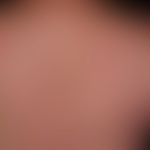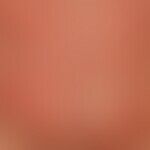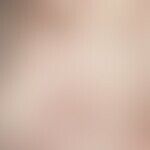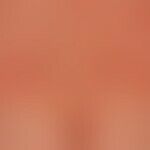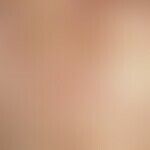Synonym(s)
DefinitionThis section has been translated automatically.
Urticaria lasting longer than 6 weeks (in many cases the clinical picture persists for > 5 years). A distinction is made according to the clinical course:
- chronic-continuous spontaneous urticaria with daily attacks
- chronic-relapsing spontaneous urticaria with an intermittent course (with wheal attacks alternating with symptom-free intervals)
The term spontaneous or idiopathic urticaria refers to the unknown aetiology and is in contrast to chronic inducible urticaria (causes known or easily ascertainable, e.g. physical urticaria, see urticaria below).
ClassificationThis section has been translated automatically.
see below Urticaria
You might also be interested in
Occurrence/EpidemiologyThis section has been translated automatically.
Prevalence data varies between 0.1 % and 0.6 %. Cumulative prevalences (number of people who have experienced urticaria at least once in their lives) are between 9% and 25%.
EtiopathogenesisThis section has been translated automatically.
- Up to 70% of the diseases are idiopathic.
- About 1/4 of patients have a positive history of atopy; total IgE is elevated in > 50% of cases.
- The model of molecular mimicry of epitopes is repeatedly discussed as a possible trigger of chronic urticaria. The model is based, for example, on the temporary presence of various antibodies (e.g. thyroid autoantibodies TAK/TPO) as well as on a temporary or permanent susceptibility to non-immunological hypersensitivity reactions (e.g. intolerance reactions characterized by non-IgE-mediated histamine release ).
- Depending on the type of urticaria, very different triggers are possible:
- Drugs or foods (non-IgE-mediated; see also intolerance reaction; biogenic amines)
- Food additives: colorants, benzoates, salicylates, sulphites, glutamates (non-IgE-mediated); the data on this is contradictory; causative in < 5 % of patients)
- Acetylsalicylic acid: no association with salicylate-containing foods (non-IgE-mediated)
- Food (IgE-mediated allergic reactions) or contamination (e.g. residues of antibiotics in meat): Such reactions are rather rare (< 1% in children and adults).
- Bacterial infections (Helicobacter pylori [there is the highest level of evidence for this mode of infection], streptococci, staphylococci, Yersinia); for infections in the dental and ENT area, there are no confirmed correlations between therapy and the course of urticaria, although such correlations have been postulated in individual cases.
- Viral infections (there are reports of hepatitis virus infections and norovirus infections [no convincing evidence to date])
- Parasites (lamblia, entamoebae, worm infections; trichomonads, trichinella, toxocara canis)
- Autoimmune processes (autologous serum test, thyroid autoantibodies - see autoreactive urticaria)
- Rare: tumors, hepatitis
ManifestationThis section has been translated automatically.
Women are affected about twice as often as men. The peak incidence is between the third and fourth decade of life.
ClinicThis section has been translated automatically.
Repeated or constantly occurring, raised, sharply defined, palpable, solitary or confluent, whitish to red, itchy, flat, transient skin lesions (wheals) of varying size (0.2-10.0 cm). In 52% of cases, the course of the disease is chronically recurrent. There is evidence of an increased rate (between 35% and 50% of the total collective, depending on the literature) of psychiatric comorbidities, such as: anxiety disorders, depression and somatoform disorders.
LaboratoryThis section has been translated automatically.
HistologyThis section has been translated automatically.
see below Urticaria
DiagnosisThis section has been translated automatically.
Step-by-step program for the diagnosis of chronic urticaria (according to Ring/Przybilla). The diagnosis of urticaria requires patience and the consistent execution of a clearly defined diagnostic program (discussed with the patient in advance) (see Table 1). Targeted provocation tests can be started when the patient is free of symptoms. The following provocation diets can be recommended according to the patient's medical history and previous test results:
- build-up diet
- additive-rich diet
- Diet rich in salicylates
- Biogenic amines
- Oral provocation test for idiosyncrasy (OPTI)
- Pseudoallergic/intolerance reaction: About 20 - 50 % of cases of chronic urticaria are caused by non-immunological, i.e. pseudoallergic reactions (mainly acetylsalicylic acid). An antigen-antibody reaction does not take place in these reactions. IgE cannot be detected in increased amounts. RAST determinations in this sense are therefore not possible. Pseudoallergic reactions can be triggered by various pathomechanisms, e.g. direct complement activation, direct mediator release, enzyme defects, Jarisch-Herxheimer reaction, neuro-psychogenic. The CAST (cellular antigen stimulation test) is available as a laboratory test for suspected pseudoallergic reactions. Provocation diets with biogenic amines can confirm the suspicion.
- Salicycylates: Acetylsalicylic acid is the most common substance that can trigger an intolerance reaction. The pathomechanism has not yet been clearly clarified. An inhibition of cyclooxygenase is being discussed, which leads to a lack of protective prostaglandins and to increased formation of lipoxygenase metabolites or may cause direct mediator release, direct complement activation and altered platelet reactivity. There are pronounced cross-reactions with pharmacologically similar agents, e.g. other NSAs, but also with other chemicals such as food colorings (tartrazine) and preservatives. If an intolerance reaction to ASA is known, coxibs (e.g. celecoxib) can be given if necessary.
Differential diagnosisThis section has been translated automatically.
General therapyThis section has been translated automatically.
Elimination or avoidance of the triggering factors after careful anamnesis and diagnosis.
- Focus search: Rehabilitation of a chronic focus or treatment of the underlying disease (e.g. antibiotic or surgical treatment of dental and ENT foci [no confirmed evidence]; eradication of Helicobacter pylori [high level of evidence], treatment of candida infections [no confirmed evidence]; see also candidiasis, enteric, etc.).
- In case of parasitic cause: adequate therapy
- Medication: discontinuation or conversion of possibly causative medication (e.g. analgesics, antibiotics such as penicillin, acetylsalicylic acid, insulin, vaccinations)
- If food or additives are possible triggers and other trigger factors have been ruled out, a standardized pseudoallergen-free basic diet (see Table 4) should be followed for 4-6 months. 70 % of patients experience significant improvement, even freedom from symptoms(placebo effect?). During the diet, a dietary log / symptoms log should be kept and the severity of urticaria should be assessed. About 50 % of patients tolerate a full diet again after six months.
External therapyThis section has been translated automatically.
Blande, antipruritic local therapy e.g. Optiderm lotion, Tannolact lotion, Lotio alba, Lotio Cordes, zinc oxide emulsion LAW, if necessary with addition of 2-5% polidocanol (e.g. Thesit, rp. 200 rp. 196 ) or 1% menthol rp. 160. 160. if necessary, topical glucocorticoids as lotion (e.g. Triamgalen lotion, rp. 123) or cream (e.g. Triamgalen cream, rp. 121 rp. 120). Alternatively, gels containing antihistamines (e.g. Fenistil, Tavegil, Soventol).
Radiation therapyThis section has been translated automatically.
The use of UVA irradiation can lead to clinical improvement in individual cases. UVB therapy is more reserved for cholinergic urticaria and urticaria factitia.
Internal therapyThis section has been translated automatically.
Regarding evidence-based therapy, see below Urticaria (the therapy options listed here are partly based on small study results or personal experience).
Conventional systemic therapies:
- Antihistamines: Oral administration of non-sedating antihistamines (H1-blockers) of the 2nd generation such as loratadine 10 mg (e.g. Lisino) once daily 1 tablet p.o., desloratadine 5 mg (e.g. Aerius) once daily 1 tablet p.o., Cetirizine 10 mg (e.g. Zyrtec) 1x daily 1 tbl. p.o. or levocetirizine 5 mg (Xusal) 1x daily 1 tbl. p.o. If therapy fails (after 14 days) switch to high-dose antihistamine therapy:
- High-dose antihistamine therapy: If the response is insufficient, individually adjusted dose increases (e.g. desloratadine in increasing doses up to 4 times the standard dose) can be used.
- Sedating antihistamines (therapeutic principle is considered outdated by many authors). Sedating antihistamines such as hydroxyzine (e.g. Atarax®) 1-3 tablets/day are particularly suitable for hospitalized patients at night.
Alternative combinations:
- The response to the various H1-blockers varies greatly from individual to individual, so the success of their combination must also be assessed differently. Different H1-blockers can be combined in double combinations (e.g. levocetiricin and fexofenadine) or also in triple combinations (levocetirizine and fexofenadine as well as levocetirizine in double standard dosage). Combinations with H2 receptor blockers such as cimetidine (e.g. Tagamet) 400-800 mg / day or ranitidine (e.g. Sostril) once daily 300 mg or twice daily 150 mg p.o. have also been successfully described.
Combinations of H1 blockers with a leukotriene antagonist (e.g. montelukast), especially in patients with concomitant angioedema
Combination of an H1-AH (e.g. desloratadine 10 mg / day) with dapsone (50-150 mg / day)
Alternative system therapies:
- Omalizumab (Xolair®): Approval for (therapy-resistant) chronic spontaneous urticaria has been available since 2014. Dosage: 300 mg / s.c. every 28 days. The clinical efficacy has been proven in several studies (Staubach P et al. 2016).
- Barzolovimab: blocks the receptor tyrosine kinase KIT, which is required for the function and survival of mast cells.
- Antiallergic drugs with antihistaminic and PAF-blocking effect: Rupatadine (e.g. Rupafin) 10 mg / day p.o.
- Ciclosporin (good evidence) (2.5 mg / kg bw p.o. in 2 ED). However, ciclosporin should only be used in severe, absolutely therapy-resistant chronic urticaria, possibly in combination with an H1-AH.
- Casuistic: Dapsone (low evidence): 50-100 mg / day p.o. for 3 - 6 months (no longer mentioned in the latest guideline)
- Mast cell stabilizers (low evidence): In case of additional intestinal intolerance reactions, success with disodium cromoglicic acid (4 x daily 200 mg or 400 mg 15-30 min before exposure) has been described.
- Casuistic (low evidence): Successes have been described with high-dose intravenous immunoglobulin therapy(IVIG).
- Casuistic: Plasmapheresis / immunoadsorption (low evidence). Last but not least, chronic urticaria in its pronounced form, especially after failure of other therapeutic approaches, is an indication for plasmapheresis or immune adsorption. The method appears to be particularly successful in patients in whom autoantibodies against the high-affinity part of IgE (α chain) have been detected. By binding to the IgE receptor, these AK cause degranulation and histamine release, e.g. on the surface of basophils or mast cells. In addition, this finding offers the possibility of a cost-saving reduction in the time-consuming diagnostics for some patients. At the same time, the high costs of the procedure should be noted!
- Not recommended for long-term therapy: glucocorticoids (no longer listed in the guidelines or considered obsolete): Glucocorticoids in medium doses are usually very effective in the case of pronounced findings and pronounced, therapy-resistant symptoms(pruritus). Glucocorticoids are indicated for intermittent flare activity. Prednisolone (e.g. Solu Decortin H) initially 40 - 60 mg / day i.v., gradual dose reduction to the lowest possible maintenance dose and switch to oral administration. Caution! The maintenance dose should be below the Cushing's threshold. Gastric protection is required for oral administration.
- Therapy during pregnancy: Nothing is known about H1-AH-related fruit damage. If treatment is necessary in pregnant women or nursing mothers, loratadine or cetirizine should be used in the usual dosage; the best evidence is available for loratadine. No safety data are available for H1-AH high-dose therapy.
Progression/forecastThis section has been translated automatically.
NaturopathyThis section has been translated automatically.
- Week 1:
- Nystatin Drg. 3 times/day 2 Drg.
- Ozovit powder: 2 times/day 2 measuring spoons.
- Week 2-4:
- Markalact powder: 2 times/day 3 teaspoons.
- Amara drops Pascoe: 2 times/day 10 trp.
- Hepar-Pasc 100: 2 times/day 2 tbl.
- week 5-12:
- Markalakt powder: 2 times/day 3 teaspoons.
- Hepar-Pasc 100: 2 times/day 2 tbl.
- Amara mixture: 2 times/day 30 trp. of the mixture of 25 ml Amara drops of Pascoe/20 ml Pascoepankreat Novo drops/20 ml Quassia Similiaplex drops.
- MDS: 2 times/day 30 trp.
TablesThis section has been translated automatically.
Three-step programme of urticaria diagnostics
Level |
Diagnostic measures |
I |
Basic examination with careful anamnesis |
Recording of findings | |
General clinical examination and routine laboratory | |
Allergological test procedures | |
Atopy screening (cat, HST mite, grass) | |
Food Standard (Prick) | |
Physical provocation tests (cold, heat, pressure, exertion, dermographism, light staircase if necessary) | |
If necessary, skin biopsy with direct immunofluorescence | |
Urticaria-Basis-Diet: tea-potato-rice to exclude frequent food allergies | |
II |
Intensive Care Unit |
Diet diary | |
Infect allergic focus search (e.g. gastroscopy with Helicobacter pylori testing, C13 breath test) | |
III |
Elimination diet and provocation testing |
Elimination diet: Suspicious substances are removed one after the other and the clinical response is assessed. | |
Exploratory diet / provocation diet: Certain foods are given in sequence under control of the clinical findings. Reliable evaluation is only possible if the patient has been free of symptoms for at least 2 days before the test. | |
Oral provocation test for idiosyncrasy (OPTI) |
Urticaria diagnostics (proposal for an in-patient diagnostic programme)
Physical causes | |||
Dermographism |
occurs O |
positive O |
negative O |
Cold test/heat test |
occurs O |
positive O |
negative O |
Autologous serum test |
occurs O |
positive O |
negative O |
Print test |
occurs O |
positive O |
negative O |
Sweat test |
occurs O |
positive O |
negative O |
Doryl test (on the ward / allergy laboratory) |
occurs O |
positive O |
negative O |
(light stairs) |
occurs O |
positive O |
negative O |
Laboratory | |||
BSG |
occurs O |
increased O |
normal O |
Leukocytes |
occurs O |
increased O |
normal O |
Eosinophils |
occurs O |
increased O |
normal O |
ASL |
occurs O |
increased O |
normal O |
RF |
occurs O |
increased O |
normal O |
ANA |
occurs O |
increased O |
normal O |
Complement (C3,C4, CH50,C1-esterase inhibitor) |
occurs O |
increased O |
diminishedO |
Total IgE |
occurs O |
increased O |
normal O |
SX-1 |
occurs O |
positive O |
negative O |
RAST (Specific IgE) |
occurs O |
increased O |
negative O |
CAST |
occurs O |
increased O |
normal O |
CD 4/8 ratio |
occurs O |
pathol O |
normal O |
Thyroid hormones (T3, T4, TSH) |
occurs O |
increased O |
normal O |
SD-AK (MAK, TAK, TRAK, TPO) |
occurs O |
increased O |
normal O |
Hepatitis Serology |
occurs O |
positive O |
negative O |
Cryoglobulins |
occurs O |
increased O |
normal O |
Porphyrins |
occurs O |
increased O |
normal O |
Yersinia-KBR |
occurs O |
positive O |
negative O |
Candida AK |
occurs O |
positive O |
negative O |
Focal events | |||
Imprint tongue e.g. oral candidiasis |
occurs O |
positive O |
negative O |
stool on yeasts, parasites, pathogenic germs |
occurs O |
positive O |
negative O |
Vaginal swab on yeast |
occurs O |
positive O |
negative O |
Gynaecological consultation |
occurs O |
Focus O |
undetected. O |
ENT-Consultation |
occurs O |
Focus O |
undetected. O |
Dental Consil |
occurs O |
Focus O |
undetected. O |
Urological consultation |
occurs O |
Focus O |
undetected. O |
Rö-NNH |
occurs O |
Focus O |
undetected. O |
Orthopantomogram |
occurs O |
Focus O |
undetected. O |
Rö-Thorax |
occurs O |
Focus O |
undetected. O |
Abdomen Sonography |
occurs O |
Focus O |
undetected. O |
Gastroscopy with Helicobacter rapid test |
occurs O |
Focus O |
undetected. O |
Skin tests (allergy laboratory) | |||
After antihistamine free interval of 35 days |
|||
Prick test: inhalation allergens, food, additives, medicines |
occurs O |
positive O |
negative O |
Scratch test - food, medicines |
occurs O |
positive O |
negative O |
Friction test - food |
occurs O |
positive O |
negative O |
Intracutaneous test (not for Urticaria factitia) |
occurs O |
positive O |
negative O |
Multitest-Merieux |
occurs O |
conspicuous O |
undetected. O |
Exposure tests | |||
Dyestuff mix |
occurs O |
conspicuous O |
undetected. O |
Preservative mix |
occurs O |
conspicuous O |
undetected. O |
Potassium metabisulphite |
occurs O |
conspicuous O |
undetected. O |
Indomethacin |
occurs O |
conspicuous O |
undetected. O |
Acetylsalicylic acid |
occurs O |
conspicuous O |
undetected. O |
Placebo |
occurs O |
conspicuous O |
undetected. O |
Paracetamol |
occurs O |
conspicuous O |
undetected. O |
Ibuprofen |
occurs O |
conspicuous O |
undetected. O |
Na-glutamate |
occurs O |
conspicuous O |
undetected. O |
p-Coumaric acid |
occurs O |
conspicuous O |
undetected. O |
Provocative diet | |||
Additiva rich diet |
occurs O |
conspicuous O |
undetected. O |
Salicylate-rich diet |
occurs O |
conspicuous O |
undetected. O |
Urticaria basic diet (tea-potato-rice diet)
|
Allowed |
Forbidden |
Staple food |
Rice wafers, rice crackers, wheat rolls (wheat flour type 405, fresh yeast, sugar, iodized salt, water, corn oil) |
All other types of bread and cereals |
Potato dishes |
Boiled potatoes, fried potatoes, baked potatoes, potato rösti, potato cookies, potato pancakes, French fries |
All not mentioned |
Rice dishes |
Husked rice, brown rice, wild rice, rice noodles |
All not mentioned |
Spices |
iodized salt, sugar |
No other |
Grease |
Corn oil, Becel diet margarine |
No others, no butter |
Beverages |
Mineral water, black tea |
No other |
Oligo-Allergenic Basic Diet
Food |
Products |
Baked goods |
100% rye bread, Wasa rye crispbread (green package), Hammermühle bread: chestnut bread, millet bread, Pfälzer white bread (gluten-free), corn wafers, wafer bread, Mondamin bread (own production) |
Meat products |
Lamb, turkey (only salted, roasted with maize-germ oil or cooked) |
Vegetables |
Potatoes (cooked), mashed potatoes, fried potatoes with corn oil or French fries, broccoli, cauliflower, carrots, kohlrabi, zucchini, cucumber without skin |
Rice and noodles |
Chicken egg-free and wheat-free noodles, corn and rice noodles, rice (long grain or brown rice), Humana apple porridge or children's semolina (milk-free) both based on corn or rice |
Fruit |
Cooked unsweetened pear, apple pulp |
Greases |
Vitagen margarine (from Vitaquell), maize germ oil (with high content of polyunsaturated fatty acids) |
Sweetener |
pear syrup, sugar beet juice |
Beverages |
Calcium-rich mineral water, Humana SL, Milupa SOM, apple juice (100% naturally cloudy from Dr. Koch's) |
Egg replacement |
Egg substitute powder (e.g. hammer mill) |
Miscellaneous |
Nestargel (locust bean gum), rice wafers, cornflakes (unsweetened), popcorn, pop rice |
Build-up diet1
Food |
Products |
Dairy products |
Buttermilk, young semi-hard cheese |
Animal food |
Meat: Cold cuts, roast beef, turkey |
Fish: saithe, trout, plaice, cod | |
Eggs | |
Fruit |
banana, ripe sweet pear, watermelon |
Miscellaneous |
Fresh herbs, herbal teas, pear juice, vegetable juice, sugar beet syrup (bread topping) |
Provocation diet: Food rich in additives
Meal |
Food/Products |
Breakfast |
Whole grain bread, multivitamin jam, large quantities of cocoa drink (Kaba, Nesquick) |
Snack |
fruit yoghurt, cocktail cherries, chewing gum (Hubba Bubba, Vivil Mash), chocolate bars (Mars, Nuts) |
Noon |
instant soup (bag/Knorr, Maggi), ham rolls with mayonnaise (preserved), instant mashed potatoes, delicatessen salad, beans, spinach, red gelatine with cocktail cherries |
Coffee |
orange juice (coloured), chocolate dragees, wine gum with colouring, chewing gum |
Evening |
wholemeal bread/grey bread (preserved), salami/ham, salmon substitute, fish semi-preserved, delicatessen salad, horseradish, 2 glasses of white or red wine |
Night |
raspberry syrup drink, chewing gum, tomato juice (ready-to-drink), camembert |
Provocation diet - Salicylate-rich food: Without colouring, without seasoning
Meal |
Food/Products |
Breakfast |
Rolls/bread of your choice, diet margarine, cream cheese without additives, edible quark, jam, nut nougat cream, muesli cup, apple, dried plums, peppermint tea with sugar and lemon, 0.2 l orange juice |
Noon |
Fresh vegetable soup (leek, carrots, celery, salt, spices, herbs, potatoes), roasted or cooked meat (without ready sauce), boiled potatoes, rice (all kinds), noodles, raw vegetables (chicory, endive, paprika, radish, cucumber fresh, peas fresh, kale, gherkin, courgette, olives |
Dessert |
Red currant, raspberries with sugar or cranberry, raspberry or blueberry compote |
Afternoon |
0.2 l grape juice, pastries with almonds, peppermint tea or coffee with canned milk and sugar |
Dinner |
Bread of your choice, diet margarine, cream cheese without additives, potatoes in the skin, quark, jam, gherkin, carrots, raw vegetables (apple, lemon, onion), 0.2 l orange juice or black currant juice |
Provocation Day - Biogenic Amines
Biogenic amines |
Food/Products |
Histamine rich food |
Tuna, mackerel, raw and long-life sausages, tomatoes, sauerkraut, red wine, cheese (Emmental) |
Tyramine rich food |
raspberries, banana, oranges, Chianti wine, fish, cheese (Camembert), chocolate, cocoa |
Serotonin-rich foods |
Banana, cheese (Gouda, Edam) |
Oral provocation test for idiosyncrasy (OPTI)
Test day |
Test Substances |
Day 1 (dye mix I-II) |
Tartrazine (E 102) 25 mg; quinoline yellow (E 104) 12.5 mg; sunset yellow (E 110) 12.5 mg; azorubine (E 122) 12.5 mg; amaranth (E123) 2.5 mg; cochineal red (E 124) 20 mg; erythrosine (E127) 10 mg, also possible: patent blue (E 131); indigotine (E132); brilliant black (E 151); iron oxide (E 127). |
Day 2 (Preservative mix) |
Sorbic acid (E 200) 50 mg: Has an antimycotic effect, no effect against yeasts, is contained in bread and cheese. 2,4 unsaturated fatty acid, occurs naturally in the saturated form as caproic acid in butter. |
Na-benzoate (E 211) 50 mg: Benzoic acid occurs naturally in cranberries (in concentrations of 0.1-0.2%), has an antifungal and bacteriostatic effect. | |
PHB ester (p-OH-benzoic acid ethyl ester) (E 214) 50 mg: Ester is more antimycotic, acts even at higher pH, effective against coliform bacteria, staphylococci, streptococci, salmonella, klebsielles, proteus. | |
Day 3 (Potassium metabisulphite) |
Especially for the preservation of wine, inhibits the growth of mould and yeast from 20 mg/l. |
Day 4 (Indometacin) |
(1:1000; 1:100; 1:10; original preparation) |
Day 5 (Acetylsalicylic acid) |
(Pseudoallergy, previously CAST to ASS). Dose-dependent reaction, beginning with 50 mg, increasing in hourly intervals to 100 mg, 250 mg, 500 mg, 1000 mg. |
Day 6 (Possibly) Placebo |
|
Day 7 (other) |
E.g. paracetamol 1:1000, 1:100, 1:10, 1:1, ibuprofen 1:1000, 1:100, 1:10, 1:1, Na-glutamate (E 621) 124 Kps., p-coumaric acid 124 Kps. |
Rules of thumb for differentiating between allergic and pseudoallergic reactions (according to Ring J, Applied Allergology, MMW)
Allergy |
Pseudoallergy |
Awareness raising |
no sensitisation |
rather rare (< 5%) |
rather frequently (> 5%) |
common clinical symptoms |
often unspecific symptoms |
inducing small doses |
partly dose-dependent (e.g. infusions: speed) |
Family history sometimes positive |
Family history negative (exception: enzyme defect) |
slight psychological influence |
strong psychological influence |
Low salicylate diet (with proven ASS intolerance)
Food * |
Examples |
Fruit |
Apricots, oranges, blackberries, cherries, blueberries, gooseberries, cranberries, currants, nectarines, peaches, raspberries, strawberries, lemons |
Vegetables |
Aubergine, chicory, endive, paprika, pepperoni, radish, fresh cucumber, gherkin, zucchini |
Seeds |
Almonds |
Beverages |
aperitifs, beer, cognac, cola drinks, fruit juices from the above mentioned fruits, raspberry syrup, peppermint tea, wine |
Low pseudoallergen diet
|
Allowed |
Forbidden |
Staple food |
Bread, bread rolls without preservatives, semolina, millet, potatoes, rice, durum wheat noodles (without egg), rice wafers (only rice/salt) |
e.g. noodle products, egg pasta, cakes, French fries |
Greases |
Butter, vegetable oils (cold pressing) |
Margarine, mayonnaise etc. |
Dairy products |
Fresh milk, fresh cream, quark. natural yoghurt, unseasoned cream cheese, young Gouda |
All other dairy products |
Animal foodstuffs |
Fresh meat, fresh minced meat |
All processed animal food, eggs, fish, shellfish |
Vegetables |
lettuce, carrots, zucchini, Brussels sprouts, white cabbage, Chinese cabbage, broccoli, asparagus |
Artichokes, peas, mushrooms, rhubarb, spinach, tomatoes and tomato products, olives, peppers |
Fruit |
No fruit |
All kinds of fruit and fruit products, also dried, e.g. raisins |
Spices |
salt, chives, sugar, onions |
All other spices, no garlic, no herbs |
Sweets |
None |
All candy, sweetener, chewing gum |
Beverages |
milk, mineral water, coffee, black tea |
All other drinks, herbal teas, alcohol. Drinks |
Bread toppings |
honey, curd cheese, unseasoned cream cheese, young Gouda |
All rubbers not mentioned |
LiteratureThis section has been translated automatically.
- Buss YA et al (2007) Chronic urticaria--which clinical parameters are pathogenetically relevant? A retrospective investigation of 339 patients. J Dtsch Dermatol Ges 5: 22-27
- Engin B et al (2008) Prospective randomized non-blinded clinical trial on the use of dapsone plus antihistamine vs. antihistamine in patines with chronic urticaria. JEAV 22: 481-486
- Godse KV (2011) Omalizumab in treatment-resistant chronic spontaneous urticaria. Indian J Dermatol 56:444
- Grattan CE et al (2002) Chronic urticaria. J Am Acad Dermatol 46: 645-657
- Hein R (2002) Chronic urticaria: impact of allergic inflammation. Allergy 75: 19-24
- Guidelines of the German Dermatological Society (DGG) (2006) AWMF Guidelines Register No. 013/013
- Maurer M et al (2003) Relevance of food allergies and intolerance reactions as causes of urticaria. dermatologist 54: 138-143
- Maurer M et al (2010) Therapeutic alternatives for antihistaminic therapy of refractory urticaria. Dermatologist 61: 765-769
- Maurer M et al (2011) Efficacy and safety of omalizumab in patients with chronic urticaria who exhibit IgE against thyroperoxidase. J Allergy Clin Immunol 128:202-209
- Nettis E et al (2003) Clinical and aetiological aspects in urticaria and angiooedema. Br J Dermatol 148: 501-506
- Schulz S et al (2009) Antipruritic efficacy of a high-dose antihistamine therapy. Dermatologist 60: 564-568
- Staubach P et al(2016) Effect of omalizumab on angioedema in H1 -antihistamine-resistant chronic spontaneous urticaria patients: results from X-ACT, a randomized controlled trial. Allergy 71:1135-1144
- Stingl G (1996) New findings on the pathogenesis of chronic recurrent urticaria. dermatologist 47: 814-815
- Termeer C et al (2015) Chronic spontaneous urticaria- A treatment path for diagnosis and therapy in the practice. JDDG 13: 419-429
- Wedi B et al (2010) Infection focus and chronic spontaneous urticaria. Dermatologist 61: 758-764
- Weller K et al (2010) Chronic urticaria. Dermatologist 61: 750-757
- Zembowitz A et al (2003) Safety of cyclooxygenase 2 inhibitors and increased leukotriene synthesis in chronic idiopathic urticaria with sensitivity of nonsteroidal anti-inflammatory drugs. Arch Dermatol 139: 1577-1582
Incoming links (32)
Amines, biogenic; Analgesic intolerance syndrome (ais); Angioedema histamine-mediated; Antihistamines, systemic; Antihistamines, systemic; Chronic lymphocytic leukemia; Contact urticaria; Dermatitis herpetiformis; Focus; Focus; ... Show allOutgoing links (54)
Acetylsalicylic acid; Amines, biogenic; Analgesics; Antibiotics; Antibodies; Antihistamines, systemic; Atopy; Benzoates; Candidosis, enteral; Celecoxib; ... Show allDisclaimer
Please ask your physician for a reliable diagnosis. This website is only meant as a reference.





